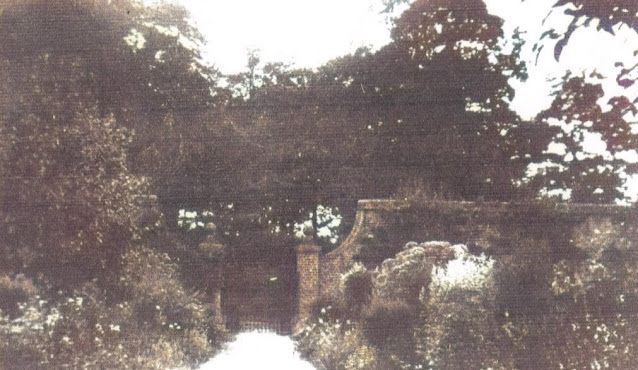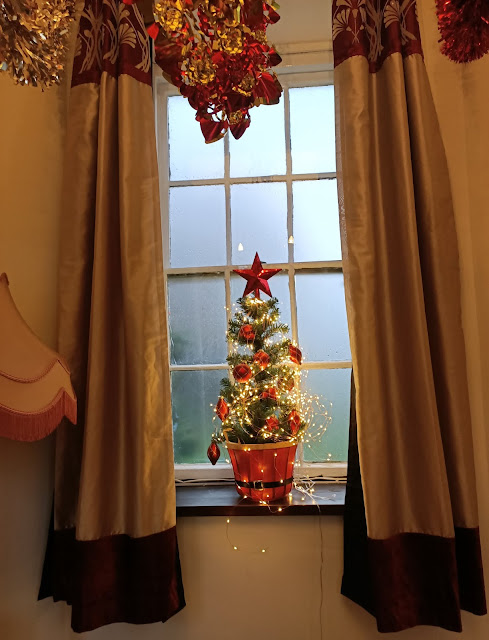The Flower Room
During our recent tours of Betley Court themed around the rebuild, we took visitors to the only room not to lose its ornate plasterwork during the fire. The room, at different periods has served as the housekeeper’s room, and ‘rear hall’ leading to the wonderfully named ‘flower room’. The mention of a flower room always piques interest. Nigel usually chimes in that ‘no good home should be without a flower room, obviously!’ to a chorus of bemused titters, on this point of the tour. A wag, at the back will often reply something along the lines of, ‘well, what would one do without a flower room?’. Others quietly boggle at the wealth of a family who could devote the space and money to creating a specific room just for the preparation of flowers for decorating the house.
The flower room was created in 1870, designed by the architect George Griffith, when he was commissioned by Thomas Fletcher Twemlow (TFT) to build a two-storey extension to the southwest corner of Betley Court. It has its own entrance from the garden, on the side of the house facing the walled garden. On plans dating from 1930, the room is shown as a small narrow room of about 4’ x 8’ (1.2 x 2.4m), with a door entering it one end and a sink and worktops under a window the other. A pipe stove or radiator is marked just inside the door. A proper workroom for the creation of flower displays for the household.
 |
| Plan showing the flower room, from a plan shared in Godfrey Brown's book, This Old House |
Betley Court’s gardeners were renowned locally for the quality of the flowers and produced in the walled gardens, and TFT invested heavily in the latest technology such as steam-heated greenhouses to provide the house with out-of-season fayre, perhaps making the investment in a flower room a little more understandable.
As wealthy Victorians, TFT and his wife Eliza would have enjoyed decorating the interior of their home with flower arrangements. It was a way of showing off their wealth and power. The larger, more numerous and elaborate your designs, the better. Usually, flower arranging was done by cultured Victorian women, who took great pride in their creations.
 |
| A Victorian lady attending to flower arranging. Artist unknown. Image from https://victorian-era.org/victorian-era-flower-arrangements.html |
The art of producing and arranging flowers was still in evidence at Betley Court between the wars. A glimpse into the role of the flower room within the daily life of Betley Court can be found from a Stafford Sentinel article dated 3rd June 1936 , when the widow of George Fletcher-Twemlow, Emma died, and estate workers rallied around to attend to her final wishes, by preparing for her funeral.
In his book, This Old House (1) , my late father-in-law Professor Godfrey Brown describes Emma Beatrice Fletcher-Twemlow from a portrait by George Jacomb-Hood that hung above the stairs at Betley Court (sadly the painting was lost in the fire of 2019). She used to loom over the staircase of the main house, along with other portraits of other former occupants, her eyes seeming to follow you down the steps as you passed (quite unnerving on a dark winter’s night). He described her as, “upright-looking” and “severely handsome”. She was portrayed wearing “a large Edwardian hat and a white elaborately flounced dress…very conscious [of her own] worth, and unlikely to be easily moved to amusement”
The Stafford Sentinel for the 3rd June 1936 (2) reports that Emma Beatrice Fletcher-Twemlow was buried at the Parish Church of St Margaret in Betley. It describes the service as a gathering of “Friends from a wide area, tenants, estate workers and villagers” who, “…paid simple tribute to the memory of Mrs Emma Beatrice Fletcher-Twemlow” in a crowded church with mourners “representing every section of village life.”
The chancel of the church was ‘beautifully decorated’ with flowers from Betley Court gardens. Outside, care had been taken to line the grave with “greens and flowers including lilies and roses” with work being attributed to members of the gardening staff. Upon her coffin, lay a “beautiful cross of red and pink carnations”, sent by her sister, Mrs Fenton. Four of the estate workers had the honour of bearing her coffin; Mr Leath (the head gardener), Mr D Barrett, Mr W Amps and Mr GW Burgess.
There’s something quite fitting about the contribution of the estate workers and gardeners to the funeral. As the ‘Lady’ of the village, she was no doubt caring towards her staff, even though, as her position demanded, she meted out punishments if things weren’t done to her satisfaction. The article sums her up as follows,
“The upkeep of the Betley Court Estate was one of Mrs. Fletcher-Twemlow's main interests, and she considerable time in assuring the well-being of her tenants and estate workers. Her kindly interest and generous disposition won for her the affection of everyone in the Betley district, and her passing has caused considerable regret.”
Emma’s funeral would have been the last time the flower room was used for such an occasion. Following her death, Betley Court became the property of her great nephew, Captain Charles Fletcher-Twemlow (Royds) and his wife Evelyn. The house became first, a Red Cross Hospital during WWII, then a miner’s rehabilitation unit before becoming Betley Court Rehabilitation Centre, an orthopaedic unit for the North Staffordshire Royal Infirmary. When the Browns restored Betley Court in the 70s, the flower room was enlarged to create a kitchen in one of the apartments. Now the flower room exists only as a room name on a plan, and as a part remembered story, a window onto how life was in the grand old English country houses of the past.
All best wishes
Ladybird Su
1. This Old House, Brown GN, Betley Court Gallery, Crewe, 1987,
2. Stafford Sentinel, 3/6/1936, accessed in the British
Newspaper Archive 6/9/22





Comments
Post a Comment